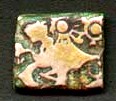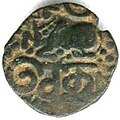This article includes a list of general references, but it lacks sufficient corresponding inline citations .(November 2007) |
Most of the pre-modern coinage used in Sri Lanka or coins used in pre-Christian Sri Lanka can be categorised as punch-marked coins, tree and swastika coins, elephant and swastika coins and Lakshmi plaques. [1]




























